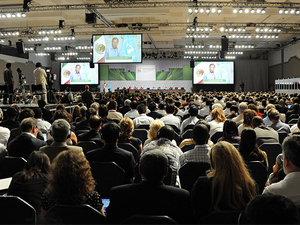Why Greening the Value Chain Took Center Stage at COP16

警察16udience - CC license by Flickr user UN Climate Talks
While the formal negotiations at COP16 slowed for the weekend on Dec. 4 and 5, the World Climate Summit facilitated dialogue among corporate executives, NGO professionals and government representatives about the sustainability actions businesses can take, which have economic benefit and at the same time stimulate government action.
While considering investments that mutually benefit the bottom line and the environment, a prevalent theme emerged — the greening of the entire value chain — which requires executives to look broadly at the complete life cycle from supplier through consumer of each product or service an organization offers.
Sustainability executives at the summit from industries such as food and beverage, IT, manufacturing and financial services agreed that the greening of the value chain should be a priority, not just among themselves, but among leaders throughout their organizations. Business customers’ and investment analysts’ demands for greater transparency and environmental compliance are prompting these companies to initiate or advance sustainability strategies, despite the lack of an international agreement on climate change and uncertainty at the national and sub-national levels.
As businesses respond to stakeholder requests, such as supplier scorecards, two questions linger: What are customers and analysts doing with the data they collect, and are they altering decisions or advice based on the responses? Time will tell; however, executives at the summit and in other meetings I attended at COP16 believe that examining and improving the eco performance of the value chain is becoming a business imperative as stakeholders begin to use this data to form opinions about companies. Effectively done, these activities can unlock hidden value, including enhancing revenue, reducing costs and minimizing risk.
Understanding the climate change implications of the entire value chain can highlight opportunities and risks throughout the enterprise. Besides the financial benefit, a business can achieve operational efficiencies, better comply with laws and regulations and improve its brand and reputation. Supply chain management now has a strategic role to play in an increasingly competitive landscape. This issue is detailed in a recent report from Ernst & Young.
As we heard throughout COP16 and in reports after the meeting concluded, business alone cannot solve the climate change problem without government involvement. However, throughout my time in Mexico I heard a loud and clear message from many influencers: “Business needs to lead by example” to increase its influence with the government.
Savvy executives are taking these conversations further by sharing their experiences and leading practices industry-wide. It’s one way that companies can reduce their environmental footprint, help design the blueprint of the new, greener economy, and motivate complementary policy making.
The views expressed herein are those of the author and do not necessarily reflect the views of Ernst & Young LLP.
警察16udience - CC license by Flickr user联合国气候谈判
